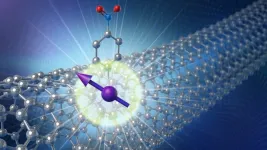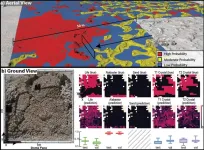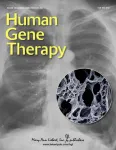(Press-News.org) Scientists find that a tubular nanomaterial of carbon makes for ideal host to keep quantum bits spinning in place for use in quantum information technologies.
Scientists are vigorously competing to transform the counterintuitive discoveries about the quantum realm from a century past into technologies of the future. The building block in these technologies is the quantum bit, or qubit. Several different kinds are under development, including ones that use defects within the symmetrical structures of diamond and silicon. They may one day transform computing, accelerate drug discovery, generate unhackable networks and more.
Working with researchers from several universities, scientists at the U.S. Department of Energy’s (DOE) Argonne National Laboratory have discovered a method for introducing spinning electrons as qubits in a host nanomaterial. Their test results revealed record long coherence times — the key property for any practical qubit because it defines the number of quantum operations that can be performed in the lifetime of the qubit.
Electrons have a property analogous to the spin of a top, with a key difference. When tops spin in place, they can rotate to the right or left. Electrons can behave as though they were rotating in both directions at the same time. This is a quantum feature called superposition. Being in two states at the same time makes electrons good candidates for spin qubits. Spin qubits need a suitable material to house, control and detect them, as well as read out information in them. With that in mind, the team chose to investigate a nanomaterial that is made from carbon atoms only, has a hollow tubular shape and has thickness of only about one nanometer, or a billionth of a meter, roughly 100,000 times thinner than the width of a human hair.
“Much to our gratification, our chemical modification method creates an incredibly stable spin qubit in a carbon nanotube.” — Jia-Shiang Chen, chemist at Center for Nanoscale Materials at Argonne and Center for Molecular Quantum Transduction at Northwestern University
“These carbon nanotubes are typically a few micrometers long,” said Xuedan Ma. “They are mostly free of fluctuating nuclear spins that would interfere with the spin of the electron and reduce its coherence time.”
Ma is a scientist in Argonne’s Center for Nanoscale Materials (CNM), a DOE Office of Science user facility. She also holds appointments at the Pritzker School of Molecular Engineering at the University of Chicago and Northwestern-Argonne Institute of Science and Engineering at Northwestern University.
The problem the team faced is that carbon nanotubes by themselves cannot maintain a spinning electron at one site. It moves about the nanotube. Past researchers have inserted electrodes nanometers apart to confine a spinning electron between them. But this arrangement is bulky, expensive and challenging to scale up.
The current team devised a way to eliminate the need for electrodes or other nanoscale devices for confining the electron. Instead, they chemically alter the atomic structure in a carbon nanotube in a way that traps a spinning electron to one location.
“Much to our gratification, our chemical modification method creates an incredibly stable spin qubit in a carbon nanotube,” said chemist Jia-Shiang Chen. Chen is a member of both CNM and a postdoctoral scholar in the Center for Molecular Quantum Transduction at Northwestern University.
The team’s test results revealed record long coherence times compared to those of systems made by other means — 10 microseconds.
Given their small size, the team’s spin qubit platform can be more easily integrated into quantum devices and permits many possible ways to read out the quantum information. Also, the carbon tubes are very flexible and their vibrations can be used to store information from the qubit.
“It is a long way from our spin qubit in a carbon nanotube to practical technologies, but this is a large early step in that direction,” Ma said.
The team’s findings were reported in Nature Communications. In addition to Ma and Chen, authors include Matthew D. Krzyaniak and Michael R. Wasielewski (Northwestern University), Kasidet Jing Trerayapiwat and Sahar Sharifzadeh (Boston University), Lei Sun (Westlake University) and Tijana Rajh (Arizona State University).
The work was supported by the DOE Office of Basic Energy Sciences and National Science Foundation.
About Argonne’s Center for Nanoscale Materials
The Center for Nanoscale Materials is one of the five DOE Nanoscale Science Research Centers, premier national user facilities for interdisciplinary research at the nanoscale supported by the DOE Office of Science. Together the NSRCs comprise a suite of complementary facilities that provide researchers with state-of-the-art capabilities to fabricate, process, characterize and model nanoscale materials, and constitute the largest infrastructure investment of the National Nanotechnology Initiative. The NSRCs are located at DOE’s Argonne, Brookhaven, Lawrence Berkeley, Oak Ridge, Sandia and Los Alamos National Laboratories. For more information about the DOE NSRCs, please visit https://science.osti.gov/User-Facilities/User-Facilities-at-a-Glance.
Argonne National Laboratory seeks solutions to pressing national problems in science and technology. The nation’s first national laboratory, Argonne conducts leading-edge basic and applied scientific research in virtually every scientific discipline. Argonne researchers work closely with researchers from hundreds of companies, universities, and federal, state and municipal agencies to help them solve their specific problems, advance America’s scientific leadership and prepare the nation for a better future. With employees from more than 60 nations, Argonne is managed by UChicago Argonne, LLC for the U.S. Department of Energy’s Office of Science.
The U.S. Department of Energy’s Office of Science is the single largest supporter of basic research in the physical sciences in the United States and is working to address some of the most pressing challenges of our time. For more information, visit https://energy.gov/science.
END
An innovative twist on quantum bits: Tubular nanomaterial of carbon makes ideal home for spinning quantum bits
2023-03-06
ELSE PRESS RELEASES FROM THIS DATE:
LOINC continues facilitating health data interoperability with biannual issuance of new concepts
2023-03-06
INDIANAPOLIS -- LOINC® from Regenstrief Institute is issuing its semi-annual release, which contains 608 new concepts to help health systems, laboratories and other health organizations accurately exchange medical data. Some of the new information has been released in coordination with the U.S. Food and Drug Administration, the U.S. Centers for Disease Control and Prevention and the Association of Public Health Laboratories.
“Aligning the release of LOINC with emerging healthcare trends is an important component of our mission and critical in promoting effective health information exchange among providers, patients and health systems,” said Marjorie Rallins, ...
New study uncovers key culprit behind pediatric brain cancer metastasis
2023-03-06
New research pinpoints a key cause of metastasis from an aggressive form of brain cancer in children and provides a potential new therapy for treating these tumors in the future.
In a paper, published in Nature Cell Biology, physician-scientists from the University of Pittsburgh and UPMC Children’s Hospital of Pittsburgh discovered that medulloblastomas hijack a skill that normal brain cells use during their early development and then manipulate it to help tumors spread.
“Children with medulloblastomas that have not yet metastasized may have a high likelihood of long-term survival, but if ...
Can artificial intelligence help find life on Mars or icy worlds?
2023-03-06
March 6, 2023, Mountain View, CA – Wouldn’t finding life on other worlds be easier if we knew exactly where to look? Researchers have limited opportunities to collect samples on Mars or elsewhere or access remote sensing instruments when hunting for life beyond Earth. In a paper published in Nature Astronomy, an interdisciplinary study led by SETI Institute Senior Research Scientist Kim Warren-Rhodes, mapped the sparse life hidden away in salt domes, rocks and crystals at Salar de Pajonales at the boundary of the Chilean Atacama Desert and Altiplano. Then they trained a machine learning model to recognize the patterns and rules associated with their distributions ...
Geosciences at the Crossroads of America
2023-03-06
Boulder, Colo., USA: Oklahoma State University is hosting the 57th annual meeting of the Geological Society of America’s South-Central Section on 13–14 March. The meeting will have a diverse program of workshops, technical sessions, short courses, and field trips that covers a spectrum of geologic disciplines.
The list below highlights a selection of environmental-related session topics you might like:
· Tar Creek Superfund Site Field Trip (Field Trip)
Managed Aquifer Recharge in the Arbuckle Simpson Aquifer (Field Trip)
Geoscience Career Workshop: Career Planning and Networking
· Hydrogeologic Challenges and Roles ...
Gene and cell therapies to combat pancreatic cancer
2023-03-06
Pancreatic cancer is an incurable form of cancer, and gene therapies are currently in clinical testing to treat this deadly disease. A comprehensive review of the gene and cell biotherapies in development to combat pancreatic cancer is published in the peer-reviewed journal Human Gene Therapy. Click here to read the article now
The article titled “Pancreatic Cancer Cell and Gene Biotherapies: Past, Present and Future,” contributed by corresponding author Pierre Cordelier, from the University of Toulouse, and coauthors, ...
Oncotarget | HALP score: Prognostic ability in cancers - a literature review
2023-03-06
“In the last several years, the Hemoglobin, Albumin, Lymphocyte, Platelet Score (HALP) has emerged in the literature as a new prognostic biomarker [...]”
BUFFALO, NY- March 6, 2023 – A new review paper was published in Oncotarget's Volume 14 on February 25, 2023, entitled, “What is hemoglobin, albumin, lymphocyte, platelet (HALP) score? A comprehensive literature review of HALP’s prognostic ability in different cancer types.”
Since its inception, the Hemoglobin, Albumin, Lymphocyte, Platelet (HALP) Score has gained attention as a new prognostic biomarker to predict several clinical outcomes in a multitude ...
Nationwide study finds that women have greater risk of mortality than men after coronary artery bypass surgery
2023-03-06
Compared with men, women continue to have a roughly 30-40 percent higher risk of dying following coronary artery bypass surgery, according to a large study led by investigators at Weill Cornell Medicine and NewYork-Presbyterian/Weill Cornell Medical Center. The analysis showed that, without adjusting for differences in age and other health factors that influence risk, the female bypass patients had a 2.8 percent rate of death during or soon after surgery, compared with 1.7 percent for male patients, a nearly 50 percent difference that only dropped 10-20 percent after accounting for these factors.
The study, which appears Mar. 1 in JAMA Surgery, was based on ...
Assessing the risk of excess folic acid intake
2023-03-06
It is well established that folic acid supplementation can significantly reduce the risk of birth defects, including neural tube defects like spina bifida, the most common birth defect of the central nervous system and the second most common of all structural birth defects. More than 80 nations, including the U.S. 25 years ago, have established mandated folic acid food fortification programs, which have been successful.
“However, there is a lack of research on whether excessive folic acid intake has the potential ...
Geisinger study supports genetic testing for people with cerebral palsy
2023-03-06
DANVILLE, Pa. – A Geisinger meta-analysis of recent research on the genetics of cerebral palsy (CP) provides evidence that genetic testing should be offered as the standard of care for people with the disorder, similar to current recommendations for individuals with other neurodevelopmental disorders (NDD). The findings were published Tuesday in JAMA Pediatrics.
Individual cases of CP—a condition that affects movement, balance and posture—have often been attributed to birth asphyxia, although recent studies show that asphyxia accounts for less than 10% of cases. A growing body of evidence suggests that a significant proportion of CP is caused by genetic changes, ...
New Geology articles published online ahead of print
2023-03-06
Boulder, Colo., USA: Article topics and locations include the Red Lake greenstone belt, Canada; Anak Krakatau volcano, Indonesia; martian soil; Glacial Lake Missoula, Montana, USA; and findings from IODP Expedition 385. These Geology articles are online at https://geology.geoscienceworld.org/content/early/recent .
Crustal conductivity footprint of the orogenic gold district in the Red Lake greenstone belt, western Superior craton, Canada
Ademola Q. Adetunji; Gaetan Launay; Ian J. Ferguson; Jack M. Simmons; Chong Ma ...
A magnetotelluric (MT) study across the Red Lake greenstone belt of the ...






